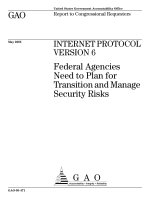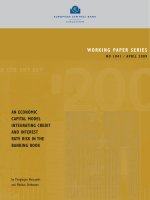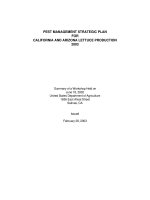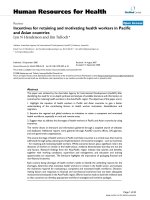Build up plan for credit and capital mobilization strategy in 2011-2015 at Vietcombank Daklak
Bạn đang xem bản rút gọn của tài liệu. Xem và tải ngay bản đầy đủ của tài liệu tại đây (1.42 MB, 78 trang )
GRIGGS UNIVERSITY
GLOBAL ADVANCED MASTER OF BUSINESS ADMINISTRATION PROGRAM
CAPSTONE PROJECT REPORT
BUILD UP PLAN FOR CREDIT AND CAPITAL
MOBILIZATION STRATEGY IN 2011-2015
AT VIETCOMBANK DAKLAK
GROUP 1 MEMBER:
1. LE THI MINH ANH
2. PHAN NGOC DIEN
3. NGUYEN DANH QUANG
4. VU THI QUE
5. BIEN VAN THANH
HCM City – 2011
BUILD UP PLAN FOR CREDIT AND CAPITAL MOBILIZATION
CAPSTONE PROJECT REPORT GROUP 1
- 2 -
TABLE OF CONTENTS
Introduction 8
Chapter 1. Scientific basic for research on bulding up credit and capital
mobilization strategy 11
1.1. Concept, role and characteristics of strategic management 11
1.1.1. Concept 11
1.1.2. Role and characteristics 11
1.1.3. Strategic management process 12
1.2. Credit and capital mobilization of the bank 19
1.2.1. Capital mobilization 19
1.2.2. Credit operation 20
1.3. The need to improve credit performance and capital raising of
Vietcombank Daklak in 2011-2015 20
Chapter 2 : Analysis and assessment on current situation of credit operation
and capital mobilization at Vietcombank Daklak 23
2.1. Overviews of Vietcombank’s activities 23
2.1.1. The formation and development of Bank for Foreign Trade of Vietnam-
Vietcombank 23
2.1.2. The formation and development of Joint Stock Commercial Bank for Foreign
Trade of Vietnam – Daklak branch 24
2.2. Current situation of capital raising and credit activities 30
2.2.1. Capital Mobilization 30
2.2.2. Credit Operation 33
2.3. Competitive situation of Vietcombank and other commercial banks in
main activities 34
2.3.1. Analysis of indicators of asset size 34
BUILD UP PLAN FOR CREDIT AND CAPITAL MOBILIZATION
CAPSTONE PROJECT REPORT GROUP 1
- 3 -
2.3.2. Targets for raising capital 35
2.3.3. Indicators of credit operation 37
2.3.4. NPL Ratio 40
2.3.5. Profit target 41
2.4. Characteristics of competitive situation and matrix of competitive image 42
2.4.1 Charateristics of competitive situation 42
2.4.2 Competitive image matrix 43
2.5 the shortcomings and limitations 44
chapter 3 : Building – proposing solutions for deployment of credit and capital
mobilization strategy of Vietcombank Daklak 2011-2015 46
3.1. Analysis application and matrix usage to evaluate and plan credit and
capital mobilization strategy of Vietcombank Daklak 2011-2015 46
3.1.1 Analysis of external environment –EFE 46
3.1.2. Banking Environment 49
3.1.3. Vietcombank Daklak micro environment analysis 54
3.1.3.1 Product 54
3.1.3.2. Price 54
3.1.3.3. Place – Distribution channel 55
3.1.3.4. Promotion 55
3.1.3.5. People 55
3.1.3.6. Process 56
3.1.3.7. Physical 56
3.1.3.8. Brandname 56
3.1.3.9. Business culture 57
3.1.3.10. Financial situation 57
3.1.3.11. Leadership 57
BUILD UP PLAN FOR CREDIT AND CAPITAL MOBILIZATION
CAPSTONE PROJECT REPORT GROUP 1
- 4 -
3.1.4 Total of evaluation of the internal factor environment of VCB Daklak 57
3.2. Analysis of swot matrix, IFE & EFE matrix for planning and strategy
selection 59
3.3. Build up stratey and proceed strategy implementation solution 62
3.3.1. Strategies development 62
3.3.1.1. Capital mobilization strategy 63
3.3.1.2. Credit strategy 63
3.3.1.3. Personnel training and retraining strategy 64
3.3.2. Steps for implementation strategy 64
3.3.2.1. Capital mobilization strategy 64
3.3.2.2. Credit strategy 67
3.3.2.3. Strategy for personel training and retraining 72
3.3.3. Build up annual targets 75
Conclusion and suggestion 77
Reference 78
Appendix 79
LIST OF MAP
Map 1.1 : Model of comprehensive strategy 12
Map 1.2 : 5 forces model of michael E.Porter 13
Map 2.1 : Organizational structure of Vietcombank Daklak 27
LIST OF PICTURES AND CHARTS
Chart 2.1 : Economic indicators anh average growth speed 2007-2010 29
Chart 2.2 : Market share of asset of credit institution group 35
Chart 2.3 : Market share of capital mobilization of credit 35
BUILD UP PLAN FOR CREDIT AND CAPITAL MOBILIZATION
CAPSTONE PROJECT REPORT GROUP 1
- 5 -
Chart 2.4 : Raising capital market share of credit institutions anh growth speed
compared with 2009 36
Chart 2.5 : Capital mobilization market share in 2010 36
Chart 2.6 : Capital mobilization in 2010 anh growth compared with 2009 37
Chart 2.7 : Share of outstanding credit of credit institutions 38
Chart 2.8 : Credit share and growth speed compared with 2009 38
Chart 2.9 : Outstanding credit share in 2010 39
Chart 2.10 : Outstanding credit in 2010 and the growth in compared with 2009 39
Chart 2.11 : NPL ratio of credit institutions 41
Chart 2.12 : Profit in 2010 and growth in compared with 2009 42
LIST OF TABLES
Table 1.1 : Internal factor evalution matrix ( IFE ) 16
Table 1.2 : External factor evalution matrix ( EFE ) 16
Table 1.3 : SWOT matrix 17
Table 2.1 : Some general indicator of business result 28
Table 2.2 : Capital mobilization structure 32
Table 2.3 : The Growth rate of mobilized capital 32
Table 2.4 : Credit structure over a few years 34
Table 2.5 : Competitive image matrix 43
Table 3.1 : Matrix to evaluate external factor environment (EFE ) 53
Table 3.2 : Matrix of internal factor evaluation 58
Table 3.3 : SWOT summary table 60
Table 3.4 : I-E matrix, inner-outer matrix of the branch 61
BUILD UP PLAN FOR CREDIT AND CAPITAL MOBILIZATION
CAPSTONE PROJECT REPORT GROUP 1
- 6 -
Table 3.5 : Matrix of key strategies 62
LIST OF ABBREVIATIONS
ACB : Asia Commercial Bank
ADB : Asia Development Bank
Agribank : Vietnam Bank of Agriculture and Rural Development
BIDV : Bank for Invesment and Development of Vietnam
EFE : Extornal Factors Evaluation matrix
Eximbank : Vietnam Export Import Bank
EVN : Vietnam Electricity
FDI : Foreign Direct Investment
FII : Foreign Institutional Investor
GDP : Gross Domestic Product
IFE : Internal Factors Evaluation matrix
NPL : Nonperforming Loan
ODA : Official Development Assistance
Sacombank : Saigon Thuong Tin Commercial Joint Stock Bank
SWOT : Strengths – Weaknesses – Opportunities – Threatens
S/O : Strategy to use Opportunities by using strengths
S/T : Strategy to use strengths to overcome Threats
ROA : Return On Assets
ROE : Return On Equity
USD : United States Dollar
VCB : Joint Stock Commercial bank for Foreign Trade of Vietnam
BUILD UP PLAN FOR CREDIT AND CAPITAL MOBILIZATION
CAPSTONE PROJECT REPORT GROUP 1
- 7 -
VND : Viet nam currency
VIB : Vietnam International Bank
Vietinbank : Vietnam Joint Stock Commecial Bank for Industry and trade
WB : World Bank
W/O : Strategy to use opportunity to fix Weaknesses
W/T : Minimize weaknesses to avoid Threats
WTO : World Trade Organization
BUILD UP PLAN FOR CREDIT AND CAPITAL MOBILIZATION
CAPSTONE PROJECT REPORT GROUP 1
- 8 -
INTRODUCTION
It can be said that, in the past 5 years, the world economy in general and
Vietnamese economy in particular has been experienced the most difficult time after
the 2nd World War with the "footprint" is the bottom of the global economy from
the "storm" in 2008 monetary with the “legacy” severe impact to the end of 2009. In
2010, the economy has gradually shown signs of prosperity but to confront the risk
of inflation explosion. And in 2011, when the echo of monetary crisis has not
expired yet, the world continuosly witness demonstration, wars happening in
Central Africa, Muslim, earthquakes, disasters, and diseases…all of these have been
affecting seriously the recovery process of the economy and the investors’
confidence.
Located in the context of resonance which is affected by internal and external
factors of the global economy, Vietnamese economy continues to step into 2011,
faced with troubles. In the market, tense situation of exchange rate of US dollar,
gold prices are sometimes at peak, banks join in the race of interest rate, inflation
rate is increasing gradually Under these circumstances, the resolution of the 11th
National Party Congress affirmed that “Objectives and missions of 2011 economic-
social development plans associated with the 5 year economic-social development
plan in 2011-2015 are: Inflation restraint, macroeconomic stability, growth model
renovation, economy restructuring, social security ensuring.” Since early this year,
the Government and the Central Bank have flexible implementation of monetary
policy from tightening to loosing with tools such as basic interests rate, reservation
ratio requirement, exchange rate adjustment with a very high frequency
Vietnam Commercial Foreign Trade Bank was officially converted to a new
operational model of join stock commercial bank (2008) and joined in Ho Chi Minh
Stock Exchange (2009) in the historical period with such challenges and difficulties.
Especially, since the banks with 100% foreign capital are allowed to expand all
areas of activities in Vietnam from 1st January 2011 with plans to serve the
BUILD UP PLAN FOR CREDIT AND CAPITAL MOBILIZATION
CAPSTONE PROJECT REPORT GROUP 1
- 9 -
customers carefully and “unlimited resources”, the competitive pressures on
domestic bank in general and on Vietcombank in particular has been more fierce
than ever.
As a branch with efficient operation, with average profits achieved from 70-90
billions per year, Daklak Join Stock Commercial Bank for Foreign Trade of
Vietnam (Vietcombank Daklak) is always one of the banks playing the main role in
economic-social development plans in Daklak province. Besides the main role in
the economy, examplary leader in compliance with monetary policy of the Central
Bank; Daklak Vietcombank must also strive to deliver the maximum benefits for
shareholders.
However, in recent years, Vietcombank Daklak’s position has been threatened
seriously by the decline of market share especially mobilized capital and credit.
In comparison with mobilized capital growth in Daklak in 2010 is 47 %,
Vietcombank Daklak’s growth rate is only 35% with the market share dropped from
13% in 2009 to 12% in 2010. In mobilized capital structure, the proportion of
termed funding accounted 76% and tends to increase. This gives the advantage to
provide a stable source of capital for the branch but increases the cost of bank
capital
Similar mobilized capital, whereas the growth rate of total outstanding credit market
in 2010 was 32%, Vietcombank Daklak’s growth rate was only 25% with the
market share fell from 14% in 2009 to 13% in 2010. Bad debt ratio of the branch in
2010 was 2,6% , higher than the average rate of the entire area was 2%.
A particularly difficult problem for the branch operation in existance for many years
is a serious imbalance between mobilized capital and credit balance. To the end of
2010, Vietcombank Daklak’s total assets reached 4.348 billion VND, of which
mobilized capital was 1.433 billion, only 33% total assets. Vietcombank Daklak’s
fund just met 30% outstanding credit need (4.123 billion). The shortfall must be
offset by high interest loan from Central Bank (higher cost of borrowing rate of
BUILD UP PLAN FOR CREDIT AND CAPITAL MOBILIZATION
CAPSTONE PROJECT REPORT GROUP 1
- 10 -
15% compared with self-raising). This causes stressful pressure on the branch as
Central Vietcombank are gradually limiting the branches’ dependence on the capital
raised from the Central Government.
From the above factors, we can see that, to maintain its position in the area,
Vietcombank Daklak must do it utmost to overcome the pressure in the
environment sector is considered to have the highest competitive level in
Vietnamese market today. To solve this problem, our group decided to research and
choose the topic “ Building capital mobilization and credit strategy of
Vietcombank Daklak period 2011-2015” to help business activities of Daklak
branch sustainably develope and enhance the influence of Vietcombank’s trademark
in the area. Implementation of the common motto of Vietcombank’s entire system is
“Speed-Safty-Quality-Efficiency”; Vietcombank Daklak will be “flexible, decisive”
in managing to achieve the set objectives. Fund raising’s growth from the economy
reaches 50% with particular focus on developing capital mobilized from the
population. For credit activity, the branch will maintain a minimum market share of
15% together with strict control of credit quality with bad debt rate does not exceed
2%. Last but not least, it is important to balance credit and capital mobilization to
ensure the branch meets the needs of 60% credit activities.
BUILD UP PLAN FOR CREDIT AND CAPITAL MOBILIZATION
CAPSTONE PROJECT REPORT GROUP 1
- 11 -
CHAPTER 1
SCIENTIFIC BASIC FOR RESEARCH ON BULDING UP CREDIT AND
CAPITAL MOBILIZATION STRATEGY
1.1 CONCEPT, ROLE AND CHARACTERISTISTICS OF STRATEGIC
MANAGEMENT
1.1.1 Concept :
Business strategy is an comprehensive plan to control and use the orgnization’s
resources in the specific terms of business environment aimed at improving their
competitiveness. Strategy management is a system of decisions and ations to
establish and implement the plans to gain the objectives of business.
1.1.2 Role and Characteristics:
In similar business environment, each of company has its own special ability,
special business terms, so detailed strategy planning is completely different. Bruce
Henderson, a strategist and a founder of Boston Consulting Group believes that “ It
is impossible to coexist the two competitors if they have the same business strategy.
We need to create new differences to exist”. Therefore, in any era and to any feild
of business, process of business strategy planning is always one of the first task of
the business. Every company must develope strategies consistent with their own
internal and external factors in each period of trading, must know how to capture
the real opportunity as well as to block potential risks by establishing prior
assumptions that can occur.
Business strategy planning is a business process which outlines the assumptions as
the basic for building company’s objectives. It helps coordinate necessary activities
to be undertaken to accomplish objective and is also a control tool the initial
assumptions by comparing the actual results with the expected ones outlined in the
plan to evaluate and make adjustments if necessary.
BUILD UP PLAN FOR CREDIT AND CAPITAL MOBILIZATION
CAPSTONE PROJECT REPORT GROUP 1
- 12 -
1.1.3 Strategic management process
1.1.3.1 Environmental research – Gathering and processing information
Environmental studies are considered the most important factor and are the
beginning of the process of building and managing strategy. The environmental
elements of a company include the following things:
- The macro environment of a business includes economic, political, social,
natural, scientific and technological elements.
- The micro environment of a business is external factors to the enterprise which
determine the nature and the extent of competition in business sector. Applying
model 5 of Michael E. Porter to analyse this environment to help managers realize
the competitive factors which have direct impacts to business.
Implementation external
controls to identify
opportunities and main
threats
Establish long
term
objectives
Establish
annual
objectives
Define
vision,
mission,
and
strategic
objectives
Revies
business
objectives
Distribution
of resources
Measure
and
evaluate
strategic
implement
ation
Implement
internal controls
to identify the
strengths and the
weaknesses
Strategic
choice to
pursue
Set up
policies
Feedback
Strategy
Formation
Strategy
implementation
Strategy
Evaluation
Map 1.1 : Model of comprehensive strategy
management
Resouce : Concepts of strategic management – 50 page :
Statistical publishing house
BUILD UP PLAN FOR CREDIT AND CAPITAL MOBILIZATION
CAPSTONE PROJECT REPORT GROUP 1
- 13 -
Map 1.2 : Model of 5 competitive pressure of M.Porter
New, latent
competitors
The competitors
in the same
business
The competition
among
enterprises in the
sector
Replacing
products
Consumers
Suppliers
Bargaining
power of
suppliers
Risk of new
competitors
Bargaining
power of
consumers
Risks from products and
services
Resouce : Concepts of strategic management – 82 page;
Statistical publishing house
BUILD UP PLAN FOR CREDIT AND CAPITAL MOBILIZATION
CAPSTONE PROJECT REPORT GROUP 1
- 14 -
Gathering information:
The gathering and processing information are the most important requirements in
the stratefic process. The necessary information for strategic process includes the
following things:
External information in the market that organization needs to collect include:
economic environment, politics, law, services and infrastructure, culture,
population, and technology.
- Technological environment
- Sector environment
- Environment of suppliers – consumers’ consumption trend
- The competitors, strategy and SWOT of key competitors to understand
thoroughly the main competitors, the potential competitors, financial
ability, resources, organization structure, strengths, weaknesses,
opportunities and challenges of competitors, strategies that competitors
are and will apply.
Gathering information of internal environment: is the collection of
information inside the company including:
- Planning: all administrative activities related to preparing for the future.
The specific tasks are: prediction, goals setting, strategy proposal, policy
development, and goal establishment.
- Organization: structure and governance model of the organization: clearly
define governance structure of the enterprise, authorization…
- Leadership: efforts to orient the activities of human beings, namely
leadership, communication, group working, changing activities,
improving the quality of work, job satisfaction, need satisfaction,
changing spirit of organization, employees, and leaders.
- Control: related to all management activities to ensure the results match
reality, and consistent with the planned results
BUILD UP PLAN FOR CREDIT AND CAPITAL MOBILIZATION
CAPSTONE PROJECT REPORT GROUP 1
- 15 -
- Information System: Understanding the management information system
of the enterprise.
- Technology: Ability to grasp and to apply technology of the enterprise.
- Human resources: qualifications and skills of staff and employees of the
enterprise.
- Marketing: the process of indetifying, forcasting, establishing, and
meeting the desired needs of consumers for products or services;
marketing environmental research to identify market opportunites, market
segmentation, choosing target markets and positioning market.
- Financial resources: financial ability of the enterprise
- Strength: strengths of the enterprise.
- Weakness: weaknesses of the enterprise.
- Opportunity: opportunities to the enterprise.
- Challenge: current and future challenges.
Process information and establish strategy: from the collected data, strategists will
take steps to process, analyse, and propose strategies from which to choose one or
some of the most suitable strategies for practical implementation.
1.1.3.2 Strategy Formulation Stage
1.1.3.2.1 Summerize the results of analysis and forecasting of business
environment
Internal Factors Evaluation Matrix (IFE)
This matrix is to evaluate the strengths and weaknesses of departments of the
enterprise. Matrix construction steps are as follows:
Step 1: Define a list of 10 to 20 important factors including the strengths and the
weaknesses of the enterprise. These factors are written in column 1
Step 2: Identify the benchmarks to evaluate importance level with the strategic
position of the company from 0,0 (not important) to 1,0 (very important) for each
element. The total number of important levels of all elements must equal 1,0. These
values are recorded respectively in column 2.
BUILD UP PLAN FOR CREDIT AND CAPITAL MOBILIZATION
CAPSTONE PROJECT REPORT GROUP 1
- 16 -
Step 3: Each company will self assess the impact of each factor to the business.
The level of assessment: 4 – very strong, 3 – quite strong, 2 – quite weak, 1 – weak
Step 4: Multiplying the benchmarks of each factor with the level of their impact (=
column 2 x column 3) to determine the total impact. These results are recorded in
column 4.
Step 5: Plus the total score of the importance of each factor to determine the total
points of the importance for the organization
No matter how many elements IFE matrix has, the higest score of the importance
that a company can achieve is 4,0, the lowest is 1,0, and the average is 2,5.
Table 1.1 Internal Factor Evaluation Matrix ( IFE ).
Internal elements
Benchmark
Evaluation
Sum
(1)
(2)
(3)
(4)
Total
1,0
External Factor Evalutaion Matrix (EFE)
EFE matrix has a summary and quantification of the impact of external environment
factors to the enterprise. EFE matrix is similar to building IFE matrix. May present
briefly as follows:
Table 1.2 External Factor Evaluation Matrix ( EFE ).
External factors
Benchmark
Evaluation
Sum
(1)
(2)
(3)
(4)
Total
1,0
BUILD UP PLAN FOR CREDIT AND CAPITAL MOBILIZATION
CAPSTONE PROJECT REPORT GROUP 1
- 17 -
Column (1) lists from 10 to 20 factors including the opportunities and and
threats affecting the company and its business.
Column (2) records the benchmark of the elements with strategic position of
the company level from 0.0 (not important) to 1.0 (very important). This
assessment is based on the industry basic. The total benchmark of factors must
equal 1.0
Column (3) level of assessment: 4 – very strong, 3 – quite strong, 2 – quite
weak, 1 – very weak
Column (4) total points = column 2 x column 3
Total points accumulated in column 4 shows the strategy of the company
makes good use of external opportunities and minimizes the negative effects of
the external environment.
1.1.3.2.2 Analyse SWOT and combine strategies:
The purpose of SWOT Matrix analysis (Strengths, Weaknesses, Opportunities, and
Threats) is to analyze the strengths and weaknesses of the enterprise with the
opportunities, and threats to combine suitably the factors to assess, to identify, and
to choose an appropriate business strategy. SWOT matrix has 9 squares in which 4
squares are important factors, 4 strategic squares are squares that strategic
intersection of the appropriate boxes describing the strategic thinking and an empty
box. SWOT matrix is built according to the following basic steps:
Step 1: List out opportunities which affect strongly the business that the enterprise
needs more research
Step 2: List out possible market risks
Step 3: List out the enterprise’s strengths
Step 4: List out the enterprise’s weaknesses
Step 5: Combine internal strengths and external opportunities ( S/O square)
Step 6: Combine internal weaknesses and external opportunities (W/O square), take
advantage of external opportunities to make up for internal weaknesses.
BUILD UP PLAN FOR CREDIT AND CAPITAL MOBILIZATION
CAPSTONE PROJECT REPORT GROUP 1
- 18 -
Step 7: Combine internal strengths and external threats (S/T square), make good use
of internal strengths to overcome external threats
Step 8: Combine internal weaknesses and external threats (W/T square) to use the
opportunities to fix the weaknesses
Table 1.3. SWOT Matrix
SWOT
Opportunity: (0): 0
1
, 0
2
…
Threat (T): T1, T2…
Strength (S)
S
1
, S
2…
S/O: strategy to use
opportunities by using strengths
S/T: strategy to use
strengths to overcome
threats
Weaknesses (W)
W
1
, W
2
W/O: strategy to use
opportunity to fix weaknesses
W/T: minimize
weaknesses to avoid
threats
Analysis and evaluation by SWOT matrix to identify the strengths (S-Strength),
weaknesses (W-Weakness), opportunity (O- Opportunities), Threats (T-Threats)
from the effects of business environment for the enterprise in order to offer
strategies and solutions to capitalize strengths, overcome weaknesses, take
advantage of opportunities, constraint and control challenges
SWOT Matrix is an important tool to help managers develop four types of strategies
as below:
Strength – Opportunity strategy (SO): to use internal strengths to take
advantage external opportunities
Weakness-Opportunity strategy (WO): to improve internal weakness by taking
advantage of external opportunities
Strength-Threat strategy (ST): to use company’s strengths to avoid or reduce
the influence of external threats.
Weakness-Threat strategy (WT): these are defensive strategies to reduce the
weaknesses inside and away from the outside threats
BUILD UP PLAN FOR CREDIT AND CAPITAL MOBILIZATION
CAPSTONE PROJECT REPORT GROUP 1
- 19 -
1.1.3.3 Strategy selection stage:
In this stage, using analysis based on the results from the input stage and on
intuition to select an appropriate strategy to implement in practice.
1.1.3.4 Strategy implementation stage:
Banking activity is a service activity so in the strategy implementation period, our
group focus on researching and applying theories about Maslow Tower on human
characteristics to propose solutions and on researching 5 distance model of
Parasuraman to narrow gaps but to improve customer services.
1.2 CREDIT AND CAPITAL MOBILIZATION OF THE BANK:
Commercial bank is a type of intermediary financial institutions doing business in
the field of monetary and banking services.Through this system, idle cash resources
in the society will be mobilized, concentrated with large enough quantities to
provide credits for economic organizations, or individuals who have demands to
develop society.
Commercial bank’s activities in the economic market are relatively diversified and
complicated, involving many sectors of economic-social activities, and many kinds
of customers. Comercial bank’s activities in general can include a number of major
activities: capital mobilization, credit operations, payment services, and other added
value activities such as fund management, underwriting, investment, leasing,
consulting,…of which capital mobilization and credit operations are the two main
most key business and having great significance for the results of bank’s operation
in particular and of the economy in general.
1.2.1 Capital mobilization
In the economy, idle cash of people always exists and if this part is mobilized in
economic-social organizations, this will create funds for economy development.
BUILD UP PLAN FOR CREDIT AND CAPITAL MOBILIZATION
CAPSTONE PROJECT REPORT GROUP 1
- 20 -
The role and position as a financial intermediary, commercial banks will mobilize
idle money in the economy which meet the needs for economic-social development.
Capital mobilization plays a role in providing capital for business activities of
commercial banks which also contribute to the creation and provision of large
capital for economy
1.2.2 Credit operation
This is the activity which using the money that commercial banks have been
mobilized in the economy to meet the need of lending business capital, investment
funds for economic sectors, and capital needs for society consumption. With a
credit intermediary function, commercial banks make loans in many ways to meet
the needs of many objects.
1.3 THE NEED TO IMPROVE CREDIT PERFORMANCE AND CAPITAL
RAISING OF VIETCOMBANK DAKLAK IN 2011-2015
Administrative intergration in the economy market of Vietnam has been and will
open up opportunities for exchanges and cooperation on international monetary and
financial issues, but also requires commercial banks in Vietnam to futher accelerate
the renovation process in order to stand firm and to be able to compete equally with
foreign banks. Currently, the state of capital mobilization and credit of
Vietcombank Daklak has some matters that need attention:
The growth rate of capital mobilization and market share declines: Thanks to the
prestige and history, systematic branches spread across proinces, Vietcombank has
a stable source of capital, large scale, but the growth rate in recent years has been
lower than the ground of the whole sector, particularly much lower than the join
stock bank system leading to the decrease in capital mobilization market share,
especially capital from the population. In addition, Vietcombank’s mobilized capital
BUILD UP PLAN FOR CREDIT AND CAPITAL MOBILIZATION
CAPSTONE PROJECT REPORT GROUP 1
- 21 -
depends heavily on a number of important customers (companies, corporations,
stated groups) whose small variation will cause difficulties in liquidity to banks.
NPL ratio remains in alert:
Imbalance exist between capital mobilization structure and credit balance:
Competitive environment among banks is increasingly fierce: from 1/1/2011,
according to WTO agreements, Vietnamese Government has been gradually
removing market entry barriers for foreign banks and removing protection for
domestic banks. To the end of 2010, there were about 120 institutions of all kinds to
participate in mobilizing capital and providing credit (6 state owned Joint stock
commercial banks, 37 joint stock commercial banks, 48 foreign banks and branches,
30 financial companies, and 1 central credit fund have made competition among
banks fierce than ever.
With the scale of GDP in 2010 was about 105 billion USD, this amount was too
much. Data on China’s commercial bank system as below is an example for
comparision: to 2009, China only had 4 large state owned commercial banks (in the
areas of agriculture, investment, trade and foreign trade), 3 state owned commercial
banks for policies (import and export, agriculture, and development), 5 more banks
under Centre Government (Beijing), 18 commercial banks under local government.
Besides, only 2 private commercial banks and some foreign commercial banks with a
smaller share (about 2%). The foreign investors who want to join in banking activities
in China must mainly purchase Chinese commercial banks’ shares which are
government owned.
In Daklak province, there are 20 branches of banks and credit funds, not foreign
branches of commercial bank. Trend in the near future is that domestic banks and
foreign banks also participate in branch expansion in Daklak which creates fierce
competition among banks.
From the current situation and from the above reasons, we can see that
BUILD UP PLAN FOR CREDIT AND CAPITAL MOBILIZATION
CAPSTONE PROJECT REPORT GROUP 1
- 22 -
Vietcombank’s system necessarily need deep concern about the strategy to improve
competitiveness in capital mobilization and credit operation to reinforce its own
position in the future.
BUILD UP PLAN FOR CREDIT AND CAPITAL MOBILIZATION
CAPSTONE PROJECT REPORT GROUP 1
- 23 -
CHAPTER 2
ANALYSIS AND ASSESSMENT ON CURRENT SITUATION OF CREDIT
OPERATION AND CAPITAL MOBILIZATION AT VIETCOMBANK
DAKLAK
2.1 OVERVIEWS OF VIETCOMBANK’S ACTIVITIES
2.1.1 The formation and development of Bank for Foreign Trade of Vietnam-
Vietcombank
Joint Stock Commercial Bank for Foreign Trade of Vietnam, originally known as
Bank for Foreign Trade of Vietnam was established on 01/04/1963, ranked by State
as one of 23 special enterprises, always plays main role in Vietnam Banking system.
After 48 years, Joint Stock Commercial Bank for Foreign Trade of Vietnam has
become a multi-purpose bank. Besides being a firm position in wholesale banking
with more traditional customers are large companies and enterprises, Joint Stock
Commercial Bank for Foreign Trade of Vietnam has successfully built diversified
distribution foundation creating momentum for the expansion of retail banking
operation and meet the needs of business with high quality, modern products and
banking services. Vietcombank also invests in many other areas such as securities,
investment fund management, life insurance, real estate business, infrastructure
development, etc., through subsidiaries and joint ventures.
Vietcombank has focused on applying modern banking management methods,
expanding and upgrading branch network of branches and transaction offices. So
far, the network of Joint Stock Commercial Bank for Foreign Trade of Vietnam has
grown all over the country.
After equitization, the operational model transformation into joint stock bank with
state capital owns 93%, the bank has equity ranks 3rd in the system reach 20.744
billion. Simultaneously international networks are constantly expanded
with over 1300 bank agents in over 90 countries and territories.
BUILD UP PLAN FOR CREDIT AND CAPITAL MOBILIZATION
CAPSTONE PROJECT REPORT GROUP 1
- 24 -
Company
Joint Stock Commercial bank for Foreign
Trade of Vietnam
Address
198 Tran Quang Khai, Ha Noi
Phone
(+84-4)-39343137
Fax
(+84-4)-39241342
Website
www.vietcombank.com.vn
LOGO – BRAND IDENTITY
Business motto:
“Leading bank in Vietnam for prosperity”
2.1.2 The formation and development of Joint Stock Commercial Bank for
Foreign Trade of Vietnam – Daklak branch
Joint Stock Commercial Bank for Foreign Trade of Vietnam–Daklak branch (
Vietcombank Daklak) was established under decision No. 209 dated 10/10/1996 by
the General Director of Vietcombank and officially launched into operation on
15/01/1997
Transaction name: Joint Stock Commercial Bank – Daklak Branch (Vietcombank
Daklak).
Headquarter : 06 Tran Hung Đao, Buon Ma Thuot City – Daklak.
Phone: 05003.858000, Fax: 05003.855038
BUILD UP PLAN FOR CREDIT AND CAPITAL MOBILIZATION
CAPSTONE PROJECT REPORT GROUP 1
- 25 -
2.1.2.1 Organizational structure and function:
On the basis of function and duties, organizational structure of Vietcombank Daklak
is streamline scienctifically to ensure business requirements, and in line with reform
situation of the sector as well as with market demands. Here is the organizational
structure as below: (Map 2.1)
Board of Directors: Responsible for business operation of the branch and direct
impact on the relating departments.
Accounting Department: Consist of 15 staffs includes:
Customer directly dealing division: open accounts; work with incomings and
outgoings for customers who trade less than 15 million.
Internal transaction division: in charge of managing and storing bookkeeping
documents, accounting timely arise economic transactions, ensuring all activities of
the bank are updated promptly, accurately, and safely as prescribed. Implementation
of the budget items in accordance with the state
Budget Division: comprising 8 staffs with duties: revenue-expense related to
amounts of cash.
Customer Division: Include 2 sections: Enterprise clients and Individual clients









